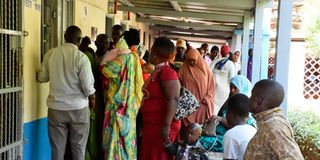Out-of-pocket health costs too much for many

Patients at Isiolo Referral Hospital. During times of economic uncertainty, citizens look up to the government for essential services like health and food.
The Covid-19 pandemic has not only exposed the gaps in health systems and infrastructure but also the high levels of vulnerabilities of individuals and households. The 2019 Kenya Population and Housing Census puts the number of the poor in the country at 19.5 million. The pandemic has increased that. The World Bank reports that, by last November, income loss had pushed two million Kenyans into poverty.
During times of economic uncertainty, citizens look up to the government for essential services like health and food. Unfortunately, National Hospital Insurance Fund (NHIF) offers limited financial protection with the poor and elderly and patients with chronic illnesses having the lowest access to them. This is in breach with Sustainable Development Goal 3, on everyone’s right to essential healthcare services, including financial risk protection.
NHIF covers just 18 per cent of Kenyans and the 32 private health insurers only one per cent. Every year, out-of-pocket (OOP) health expenditure pushes more than 100 million people below the poverty line globally due to the financial burden.
Those at the base of the pyramid experience financial hardship from OOP payments. OOP reduces access to care, undermining the health status and exacerbating well-being and socioeconomic inequalities.
OOP healthcare payments’ financial difficulties to households include its catastrophic expenditures incidence and also impoverishment. The first measures the levels of OOP payments that present financial difficulties to households and the second one the levels of such payments that exacerbate poverty. In 2014, OOP payments pushed 39 per cent of households into paucity, from 32 per cent in 2008. This shows that Kenya lags behind in protecting its people against financial risks from illnesses.
Cost-sharing
However, in 2004, the government eliminated cost-sharing at primary health facilities. User fees at hospitals were used as an additional revenue source to fund healthcare services. And in 2013, all charges, including registration cost, were abolished.
The government is increasing the health budget. But despite that, as a share of the total government budget, the portion translates to 7-9 per cent. The country lags behind in its obligation to meet the Abuja Declaration target of allocating 15 per cent of the budget to health.
In addition, the government has made a commitment to its citizens to achieve universal health coverage (UHC) by 2022 as a health policy priority. This is also a key item of the “Big Four Agenda”. It is a step in the right direction.
Clearly, most Kenyans cannot afford OOP healthcare payments. Increasing availability and access to health insurance is the most efficient in reducing financial risks associated with OOP health expenditure.
As Kenya progresses towards UHC, the barriers and the lessons learnt in the pilot phase should be incorporated. The annual increase in the health budget must be evidence-based and targeted towards attainment of UHC.
Mr Ochieng (@JOChieng85) and Ms Jattani (@DJattani) are communications officer and researcher, respectively, at Institute of Economic Affairs (IEA-Kenya).






